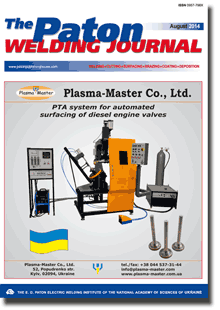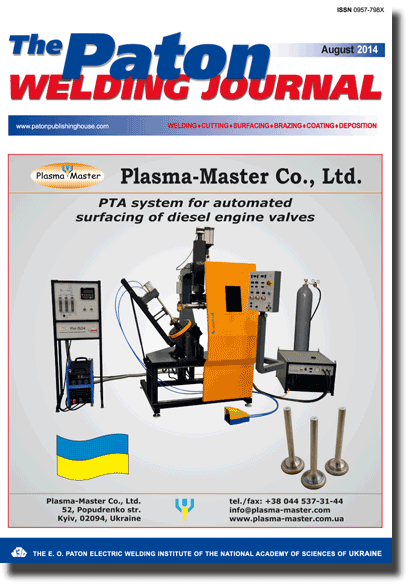| 2014 №08 (09) |
DOI of Article 10.15407/tpwj2014.08.01 |
2014 №08 (02) |

The Paton Welding Journal, 2014, #8, 8-14 pages
EFFECT OF STRESS-STRAIN STATE ON STRUCTURE AND PROPERTIES OF JOINTS IN DIFFUSION WELDING OF DISSIMILAR METALS
V.V. KVASNITSKY1, V.F. KVASNITSKY2, L.I. MARKASHOVA3 and M.V. MATVIENKO2
1NTUU «Kiev Polytechnic Institute». 37 Pobedy Ave., 03056, Kiev, Ukraine. E-mail: kvas69@urk.net
2Admiral Makarov National Shipbuilding University. 9 Geroev Stalingrada Ave., 54025, Nikolaev, Ukraine. E-mail: welding@nuos.edu.ua
3E.O. Paton Electric Welding Institute, NASU. 11 Bozhenko Str., 03680, Kiev, Ukraine. E-mail: office@paton.kiev.ua
Abstract
Computer modelling of stress-strain state (SSS) considering change of physical-mechanical properties, structural transformations and creep strains determined that distribution of plastic strains along the joint butt in diffusion welding (DW) of dissimilar materials is non-uniform. The results of mechanical tests of welded joints provide estimation not for different zones of joint but welded joint integral estimation. Aim of the work is determination of effect of SSS on structure and properties of joints in different zones of joint butt at constant temperature of DW and using temperature cycling. Welding of steel 12Kh18N10T and electric steel 10864 (armco-iron) was carried out at constant temperature 1050 °C and two temperature cycles 700-1000 °C. Welded joints were subjected to microstructural and local X-ray microanalysis. Hardness distribution was studied. Significant attention was made to study of fine structure of metal in joint zone and estimation of specific contribution of different structural constituents in total value of yield strength of the welded joints, considering dependence of dislocation density on value and intensity of plastic strain. Carried investigations confirm the results of SSS computer modelling and presence of significant zone of deformation stagnation in DW with constant temperature. It is determined that DW with temperature cycling allows controlling SSS, intensifying processes of volume interaction and providing full strength of 10864 steel joints. 12 Ref., 6 Figures.
Keywords: diffusion welding, SSS modeling, temperature cycling, structure, plastic strain, mechanical properties, diffusion
Received: 30.05.14
Published: 28.08.14
References
1. Kazakov, N.F. (1976) Diffusion welding of materials. Moscow: Mashinostroenie.
2. Derby, B. (1998) Solid state diffusion bonding: A joining and materials fabrication process. In: Vortrage und Posterbeitrage des 5. Kolloquium in der Hart- und Hochtemperaturloten und Diffusionsschweissen (Aachen 16-18 June 1998), 192, 100-103.
3. Lyushinsky, A.V. (2006) Diffusion welding of dissimilar materials. Moscow: Akademia.
4. Krasulin, Yu.L. (1971) Interaction of metals with semiconductors in solid phase. Moscow: Nauka.
5. Krasulin, Yu.L., Nazarov, G.V. (1976) Pressure microwelding. Moscow: Metallurgiya.
6. Ermolaev, G.V., Zhitnikov, N.P., Zabolotsky, V.M. et al. (1988) Vacuum diffusion welding of dispersion-hardened heat-resistant alloys with gaskets. Sudostroit. Promyshlennost, Series Welding, Issue 6, 13-23.
7. Unksov, E.P. (1955) Engineering methods of calculation of efforts in pressure treatment of metals. Moscow: Mashgiz.
8. Tarnovsky, I.Ya., Levanov, A.N., Poksevatkin, M.I. (1966) Contact stresses in plastic deformation. Moscow: Metallurgiya.
9. Makhnenko, V.I., Kvasnitsky, V.V. (2009) Stress-strain state of assemblies of the cylindrical shape in diffusion bonding. The Paton Welding J., 2, 2-7.
10. Makhnenko, V.I., Kvasnitsky, V.V. (2009) Peculiarities of formation of stress-strain state in diffusion bonds between dissimilar materials. Ibid., 8, 7-11.
11. Bokshtejn, S.Z. (1971) Structures and properties of metal alloys. Moscow: Metallurgiya.
12. Goldshtejn, M.I., Litvinov, V.S., Bronfin, B.M. (1986) Physics of metals of high-strength alloys. Moscow: Metallurgiya.
Suggested Citation
V.V. KVASNITSKY, V.F. KVASNITSKY, L.I. MARKASHOVA and M.V. MATVIENKO (2014) EFFECT OF STRESS-STRAIN STATE ON STRUCTURE AND PROPERTIES OF JOINTS IN DIFFUSION WELDING OF DISSIMILAR METALS. The Paton Welding J., 08, 8-14.The cost of subscription/purchase order journals or individual articles
| Journal/Currency | Annual Set | 1 issue printed |
1 issue |
one article |
| TPWJ/USD | 384 $ | 32 $ | 26 $ | 13 $ |
| TPWJ/EUR | 348 € | 29 € | 24 € | 12 € |
| TPWJ/UAH | 7200 UAH | 600 UAH | 600 UAH | 280 UAH |
| AS/UAH | 1800 UAH | 300 UAH | 300 UAH | 150 UAH |
| AS/USD | 192 $ | 32 $ | 26 $ | 13 $ |
| AS/EUR | 180 € | 30 € | 25 € | 12 € |
| SEM/UAH | 1200 UAH | 300 UAH | 300 UAH | 150 UAH |
| SEM/USD | 128 $ | 32 $ | 26 $ | 13 $ |
| SEM/EUR | 120 € | 30 € | 25 € | 12 € |
| TDNK/UAH | 1200 UAH | 300 UAH | 300 UAH | 150 UAH |
| TDNK/USD | 128 $ | 32 $ | 26 $ | 13 $ |
| TDNK/EUR | 120 € | 30 € | 25 € | 15 € |
AS = «Automatic Welding» - 6 issues per year;
TPWJ = «PATON WELDING JOURNAL» - 12 issues per year;
SEM = «Electrometallurgy Today» - 4 issues per year;
TDNK = «Technical Diagnostics and Non-Destructive Testing» - 4 issues per year.


